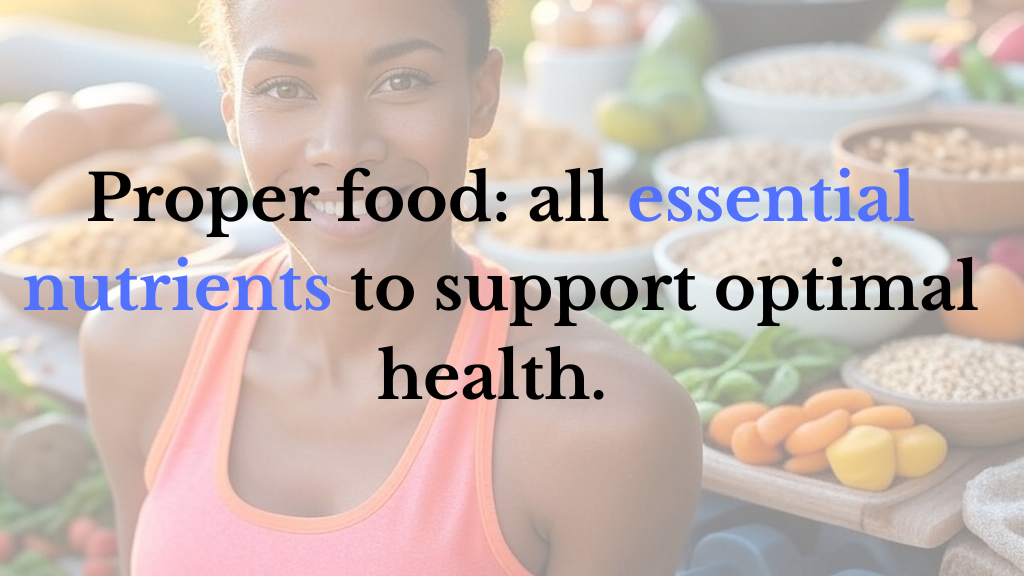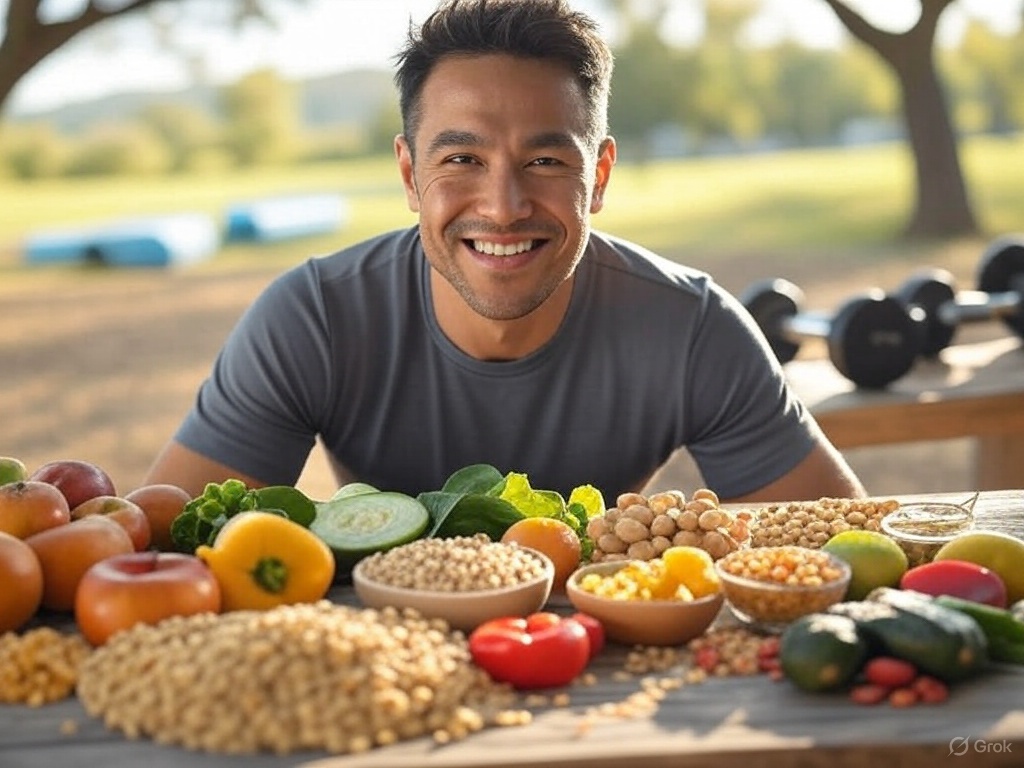Proper food and fitness are the cornerstones of a vibrant, healthy life.
A balanced diet fuels your body, while regular exercise and lifestyle habits keep you fit and fine.
But what exactly is proper food? Can you survive on milk alone? And is it safe to eat ghee with fish?
This blog answers these questions and more, offering science-backed insights and practical tips to help you thrive.
Let’s dive into the essentials of nutrition, debunk myths, and explore how to stay healthy sustainably.
What is Proper Food?
Proper food is a balanced diet that provides all essential nutrients to support optimal health. It includes:

- Macronutrients: Carbohydrates (e.g., whole grains like quinoa), proteins (e.g., chicken, lentils), and fats (e.g., avocados, olive oil) for energy and growth.
- Micronutrients: Vitamins (e.g., vitamin C from oranges) and minerals (e.g., calcium from dairy) for bodily functions.
- Water: For hydration and digestion.
Examples of Proper Food:
- A plate with grilled salmon, brown rice, steamed broccoli, and a side of yogurt.
- A smoothie with spinach, berries, almond milk, and chia seeds.
Benefits: Proper food boosts energy, strengthens immunity, supports mental clarity, and reduces chronic disease risk (e.g., diabetes, heart disease). According to Harvard Health, a balanced diet enhances longevity and well-being.
Why Do We Need Food?
Food is the body’s fuel, playing critical biological roles:
- Energy: Carbohydrates and fats provide calories for daily activities and organ function. For example, a banana offers quick energy via glucose.
- Growth and Repair: Proteins (e.g., eggs, tofu) supply amino acids to build muscles and repair tissues. Minerals like calcium strengthen bones.
- Regulation: Vitamins and minerals regulate processes like immunity (vitamin D), metabolism (B vitamins), and blood clotting (vitamin K).
Without proper food, the body depletes energy reserves, leading to fatigue, weakened immunity, and, eventually, organ failure. The World Health Organization emphasizes that adequate nutrition is vital for survival and disease prevention.
How to Stay Fit and Fine
Staying fit and fine requires a holistic approach combining proper food, exercise, sleep, and stress management. Here’s how:
- Eat Proper Food:
- Fill half your plate with fruits and vegetables for vitamins and fiber.
- Choose whole grains (e.g., oats, millet) over refined carbs.
- Include lean proteins (e.g., fish, beans) and healthy fats (e.g., nuts, ghee in moderation).
- Limit processed foods, sugary drinks, and excessive salt.
- Exercise Regularly:
- Aim for 150 minutes of moderate aerobic activity (e.g., brisk walking, cycling) weekly, per CDC guidelines.
- Add strength training (e.g., bodyweight squats, dumbbell exercises) twice a week to build muscle and bone density.
- Prioritize Sleep:
- Get 7-8 hours of quality sleep nightly to support recovery and mental health. Poor sleep disrupts hunger hormones, per Sleep Foundation.
- Manage Stress:
- Practice mindfulness, yoga, or deep breathing to reduce cortisol levels. Chronic stress can lead to overeating or weight gain.
Tip
Start small—swap soda for water or take a 10-minute walk daily. Consistency builds lasting habits.
:
Myth-Busting: Milk-Only Diets
Can you remain healthy if you only drink milk? No, a milk-only diet is unsustainable and unhealthy. While milk offers:
- Pros: Calcium, vitamin D, protein, and fats for bones and muscles.
- Cons: It lacks fiber, vitamin C, iron, and essential fatty acids found in fruits, vegetables, and grains.
Nutrient Gap Analysis:
- Fiber: Absent in milk, leading to digestive issues.
- Vitamin C: Deficiency causes scurvy (fatigue, bleeding gums).
- Iron: Low levels risk anemia, reducing energy.
- Omega-3s: Missing, impacting heart and brain health.
Long-term milk-only diets may also increase saturated fat intake, raising heart disease risk. The Mayo Clinic notes that milk is nutritious but not a complete food. A varied diet is essential for health.
Ghee and Fish: Safe or Not?
Can you eat ghee with fish? Yes, combining ghee and fish is generally safe and nutritious, though cultural perspectives vary.
- Modern Nutrition:
- Ghee provides healthy fats (e.g., conjugated linoleic acid, butyrate) that support gut health and reduce inflammation.
- Fish offers omega-3 fatty acids, protein, and vitamin D, benefiting heart and brain health.
- Cooking fish in ghee (e.g., in curries or grilling) enhances flavor and nutrient absorption. No scientific evidence suggests harm from this combo, per Healthline.
- Ayurvedic Perspective:
- Ayurveda discourages combining fish (a “heating” food) with dairy like ghee or milk, as it may disrupt digestion or increase “tamas guna” (imbalance).
- Some individuals report bloating, but this varies. Listen to your body.
Recommendation
Recommendation: Use ghee sparingly due to its high saturated fat content (1-2 teaspoons daily). Pair with fish in dishes like Bengali fish curry for a nutrient-packed meal. Consult a dietitian if you experience discomfort.
Wrapping Up
Proper food is the foundation of a healthy, active life.
By eating a balanced diet, exercising regularly, sleeping well, and managing stress, you can stay fit and fine.
Myths like milk-only diets or food combination taboos (e.g., ghee with fish) often confuse, but science shows that variety and moderation are key.
Embrace proper food as a lifestyle, not a quick fix, for sustainable health.
Start today with small changes, like adding a vegetable to your plate or trying a new fish recipe with a touch of ghee.
What’s your favorite way to enjoy proper food? Share your diet tips in the comments or try our sample meal plan for a week of balanced eating. Subscribe to our newsletter for more health insights!
Frequently Asked Questions About Proper Food
Q1: What are the best sources of proper food?
A: Whole foods like fruits (e.g., apples), vegetables (e.g., spinach), whole grains (e.g., quinoa), lean proteins (e.g., eggs, fish), and healthy fats (e.g., nuts, olive oil) are ideal. Shop local markets or check USDA’s MyPlate for guidance.
Q2: How much proper food do I need daily?
A: Portions vary by age, gender, and activity level. A general guide: 2 cups of fruits, 2.5 cups of vegetables, 6 oz of grains, 5.5 oz of protein, and 3 cups of dairy (or alternatives). Use ChooseMyPlate for personalized plans.
Q3: Is ghee healthier than butter?
A: Ghee has less lactose and a higher smoke point, making it suitable for cooking. Both are high in saturated fat, so use moderately (1-2 tsp daily). See WebMD for details.
Q4: Can I stay fit without exercise if I eat proper food?
A: Proper food supports health, but exercise is crucial for cardiovascular fitness, muscle strength, and mental well-being. Combine both for optimal results, per American Heart Association.
Q5: Why does Ayurveda avoid certain food combos like ghee and fish?
A: Ayurveda believes certain foods (e.g., fish and dairy) have opposing energies, potentially causing digestive issues. Modern science finds no universal harm, but individual sensitivities vary. Consult an Ayurvedic practitioner for personalized advice.

